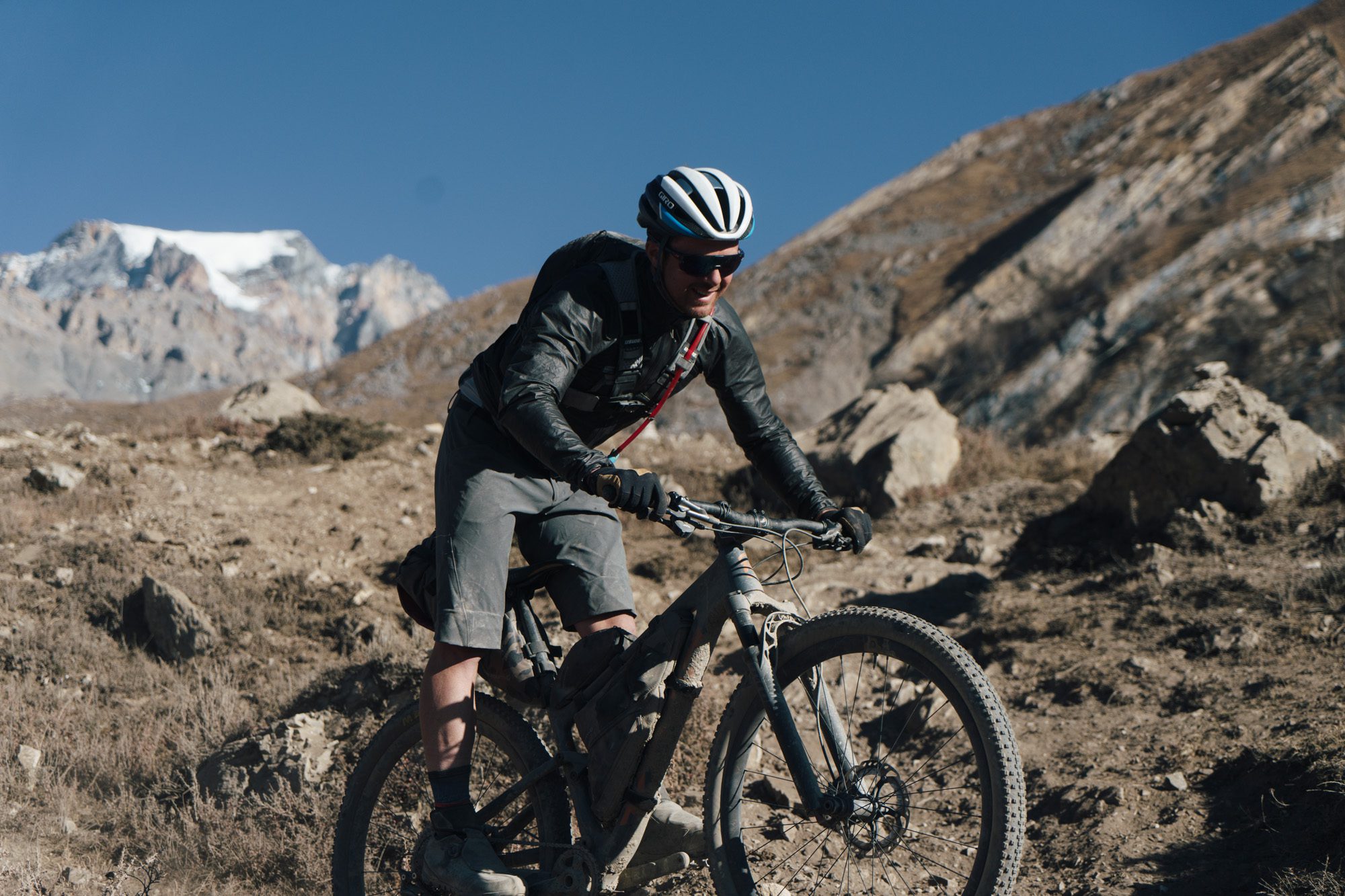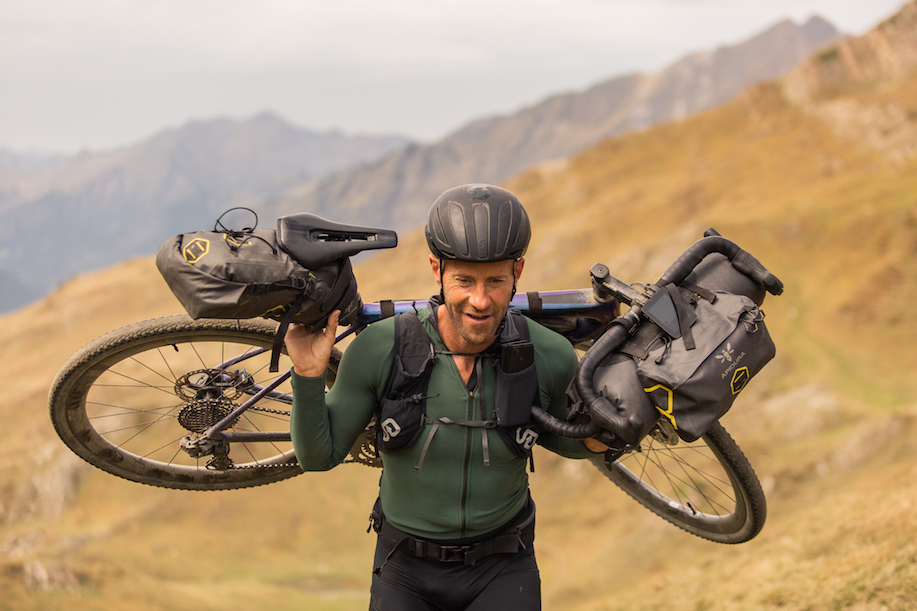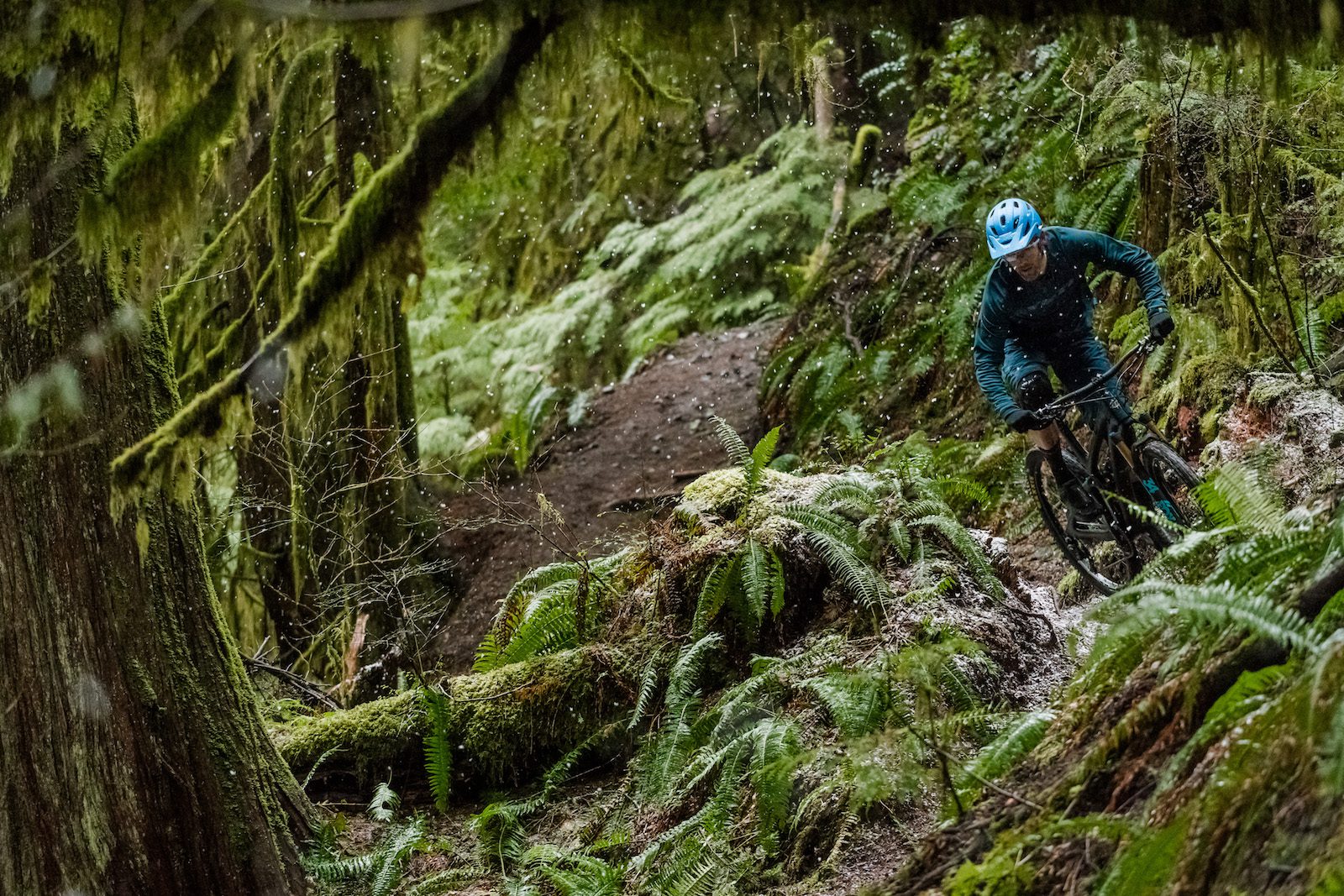Svein Tuft, Jenny Tough, Cory Wallace and Geoff Kabush on the joys of riding solo
The experienced cyclists share their favourite adventures and tips for pedalling alone
 Photo by:
Patrick Means
Photo by:
Patrick Means
by Tara Nolan
Long before the world went into self-isolation, Svein Tuft, Jenny Tough, Cory Wallace and Geoff Kabush were already pushing their limits on solo rides – and enjoying the personal rewards of their chosen experiences. These four riders have purposely tailored their riding to suit a lifestyle that prioritizes solitude – which they relish – with an occasional side of socializing.
They all have a deep yen for adventure, well beyond a quick afternoon rip through a forest. They also have the mental toughness and physical endurance to last for hours on end on the bike. Those two traits hold equal importance. You can have strong legs, but if you can’t think quickly on your feet, adapt to new elements and ride through what-ever Mother Nature decides is going to happen at any given hour, then long solo rides might not be for you. You also have to be comfortable being in your head.
When they were asked about their most memorable solo rides, all four fondly revisited their younger selves. Even though they’ve made improvements that make their riding more enjoyable now, the ill-equipped bikes of their early days and little knowledge set the stage for ambitious riding goals.
Svein Tuft
Svein Tuft may have retired from professional bike racing, but he’s still spending as much time as he can on two wheels. The ride that stands out as his most adventurous, what he calls his “biggest leap of faith,” is his first trip in Bella Coola, which involved a crappy $40 10-speed from Value Village, with a trailer welded to it, and his dog. Of course everything on the bike broke.

“Now I would never attempt something like that because I know through experience it’s such a headache,” Tuft, from Langley, B.C., says. “That’s the beauty of that era of life where we’re young and just don’t know any better. That’s something I miss now – I miss the freedom of that sensation of not knowing any better.”
These days, the multiple national time trial champion appreciates the need to plan everything out for a bikepacking trip. “I’m obsessed about those details,” he says. “I’ve done a lifetime of that stuff and like things to go smoothly.” But there is something to be said about setting that foundation to enjoy the process: making those mistakes and toughing it out when things get hard.
RELATED: Watch: Svein Tuft and Christian Meier bikepack in Andorra
“Riding is also my meditation. It’s something that settles and reorganizes everything in the mind,” he says. Nowadays, Tuft enjoys rides that take him on big loops through the Pyrenees. He’ll study the area he’s going through carefully to understand the region. “One of my favourite things about biking is it allows you to soak up the real feeling of the land – every undulation, every little town, back roads, alleys and lanes,” he explains. These are things he didn’t always get to take in when bike racing.
Tuft is keen to share some of those beautiful routes with fellow adventurous souls. He has recently opened a bike-packing shop that offers tours and rentals. It is set up to offer full catered trips and routes for solo riders. “One thing that I love so much is taking people out to the real special part of the mountains where not many people go,” he says.
Jenny Tough
Last summer, multi-disciplinary athlete Jenny Tough from Calgary did a road tour through the Dinaric Alps. “It was the first time I tried to make my tour training – and fitness – focused,” she says. “I was always trying to beat 200 km before the sun set.” Later in December, her mountain bike got all the attention and the goal was fun as she rode for the month in Nepal. “I didn’t even Strava any of it. I was just there to see the mountains and tea houses – and sleep eight hours a night.” When planning one of her big trips (some of which involve running instead of cycling), Tough will decide where she wants to go, and then what kind of bike makes sense for the type of riding she wants to do.
View this post on Instagram
Her most memorable ride was her first. At 21, she decided to pedal to the Yukon from Calgary because she’d never been to one of the country’s territories. Riding her bike there, she reminisces, made the most sense, but she didn’t have any friends who would have done that. They didn’t find out about her plan until she was about to leave and tried to stage an intervention. Of course, she went anyway. “I’d never had a bike before, I didn’t have a smartphone, I really had to figure it out the old-fashioned way. It’s probably the most important growth experience I’ve had,” she says.
Unfortunately, Tough has to acknowledge to fellow female adventurers that as a woman travelling solo, you may be on higher alert than your male counterparts. “We were all raised being aware of vulnerability,” she says. “None of that is going to switch off when you go on an adventure. Nothing has actually changed – however, you cope in day-to-day life, you can cope on this adventure.” Tough does recommend learning about the cultural differences before visiting a country, so you can be prepared.
Ultimately, what Tough loves about going solo is the independence, and learning to do things for herself. “You’re totally in the driver’s seat. You can be creative in your route choices. You learn so much by doing it solo that you wouldn’t do in a group. You learn a lot about yourself and your life. You come back a really refreshed person,” she says.
View this post on Instagram
Another benefit is a laden bicycle always attracts people wherever you are, whether it’s a gas station or a village. “If you’re in a group, you’re not as approachable,” she says. “Being solo, I find I meet more people that way.”
Cory Wallace
Having a father who was a backcountry warden helped shape Cory Wallace’s ease with going solo. The family would spend eight or nine hours a day on horseback for a couple of weeks at a time. Spending eight to 12 hours a day tree planting was an intermediary step from his youth that further helped to build his strength with mental solitude. “The first two weeks are really tough: you’re getting your head to calm down. After, you kind of get used to it,” he explains.
These days, the rider from Jasper, Alta., starts his day by meditating and recommends that others find a meditation course or book to learn the discipline. “It sets the day off on a good note,” he says. Much like tree planting, meditation can be hard at first, but gets better as you progress.Wallace’s favourite and most adventurous solo ride was doing the Annapurna Circuit in 2017. The goal was to set out on the 220-km trekking route through the Himalayas at midnight and finish in less than 24 hours. At high altitude, above 4,000 m, he started to get a little dizzy and by 5,000 m he could barely stand up straight. But he powered through and made it with three minutes to spare. Wallace has done the ride two times since, crushing his goals. He says each year has gotten easier. The only other events that are comparable are the 24-hour races he does. (He’s won three solo 24-hour world championships.) “Those send you into the same kind of mental state,” he explains. This is where the meditation comes in, as he can switch his brain off for those first 12 to 15 hours, and then switch it on toward the end when it matters.

“I’ve ridden solo more often than not. It’s just how my body is wired. I like the peace,” he says. That said, Wallace also likes to balance things out with group rides. His favourite races are the stage races in which you get to hang out with the same people. “The best part is the camaraderie,” he says.
Solo Safety Tips
Svein Tuft, Jenny Tough, Cory Wallace and Geoff Kabush all acknowledge the importance of letting someone know where you’re headed.
Svein Tuft recommends a good light set, even in times when you don’t think you need it. “The technology is so good now, you might as well have it going,” he says. The point is to make sure you’re seen. Make sure to have that flashing red light at the back.
While Geoff Kabush is an accomplished mountain biker, he says that when he rides the trails alone, he’s a bit more careful, especially when he’s off the grid. Camelbaks and other hydration packs can help organize gear. “Doing a lot of trans enduro races, you learn to make sure you have everything, like spares on the bike, to make sure you can get out of the woods and home,” he says. “The biggest thing is knowing when the sun sets and making sure you have a lot more time than planned.”
RELATED: Every gram of Rob Britton’s bikepacking kit
“A smartphone is really your best friend,” says Jenny Tough. “It’s your camera, diary, phone and access to social media and navigation.” Tough will also pack her first-aid kit according to where she’s going. Also, she’s a big fan of SPOT trackers – she attaches one to her bike – because they mean she doesn’t have to call someone every day to check in.
When Cory Wallace is riding in an area without cellphone service, he uses a Garmin inReach so people can follow him live. It also features an SOS button: “That’s my lifeline if anything goes bad.” Wallace also admits to getting off his bike to walk if conditions are too gnarly. He doesn’t take chances on solo rides and will tone it down.
Geoff Kabush
Growing up in a small town, Geoff Kabush simply didn’t have a lot of people to ride with. “When you’re solo, you become really aware of your surroundings,” he explains. “I did a lot of sports growing up. What I loved about mountain biking was getting out there and exploring myself.” As a kid, Kabush liked to piece together the fire roads he rode around Courtenay, B.C., riding all the trails, drawing his own maps and seeing how everything connected on those maps.

Nowadays, his long rides are on the road and made easier by specific, chosen destinations. For example, on a long weekend, he rode the 240 km from Victoria to Courtenay. “I’ve always enjoyed those long solo days,” he says. “I really enjoy having that time alone on the bike with my thoughts to regroup, plan, process and prioritize, so when I get back home I can get to work on stuff.”
When the mountain bike beckons, Kabush will get out for a solo singletrack rip. “On the mountain bike, I really enjoy riding solo, exploring, making all the decisions, and being in tune with my body and the trail,” he says. “I ride solo a lot because of circumstances and not many peers to ride with.” But when an opportunity arises, group rides are welcome for the social aspect. “I really enjoy it, especially back in Squamish, when I can ride with some friends. It’s super fun to explore new trails. Riding with people better than you can push you a bit.”
The Olympian with 15 national titles likes to look for what he describes as “funner” long events, such as last year’s Unbound Gravel. Kabush flatted pretty early on and rode by himself for more than nine hours. “You kind of go into a meditative state on the bike,” he says. “I’ve had times where I almost black out for 45 minutes and come back and wonder how I go to this point.”
Dealing with the highs and lows
“On my first solo rides, the highs and lows would be really high and low. But like riding mountains, ups and downs will pass,” says Jenny Tough, who says one of the hardest things about going alone is you don’t have a buddy to keep you in good spirits. She’ll cycle sometimes with really cheap headphones – that allow her to still hear traffic – listen to a podcast or music and focus on the things she’s grateful for.
If you’ve never done a long solo ride, choose an adventure close to home that maybe scares you a little bit, recommends Cory Wallace. “You have to expand your comfort zone, and don’t go too hard too fast. Let your body adapt to it. Once you get out there, the world’s a pretty welcoming place,” he says.

